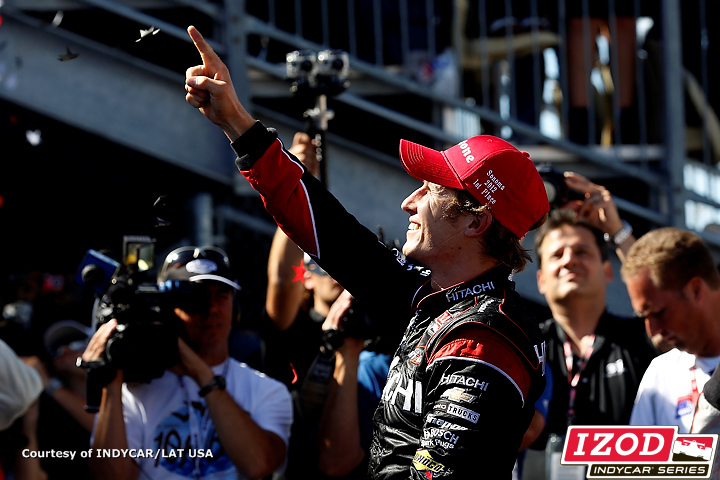Random thoughts from the Sonoma IndyCar race
 |
| A happy Ryan Briscoe |
| IndyCar/LAT USA |
Sunday's IndyCar race at Sonoma was enjoyable to watch and the series is still making forward strides. It was nice to see Rubens Barrichello get a top five finish (you're not in Kansas anymore, Rubens). It's good to have the series revisiting some legendary venues.
The battle between Sebastian Bourdais and Joseph Newgarden was fantastic. Thankfully, Newgarden appeared unhurt after his enormous impact with the wall when he and Bourdais crashed late in the race (IndyCar reported after the release of this story that Newgarden had injured his left index finger).
But when Will Power's “push to pass" button stopped working late in the race, I couldn't help but reconsider just how far IndyCar has wandered from its roots.
The infamous “push to pass" buttons are a colossal failure. No, more than that. They are an embarrassment. Push to pass is an open admission that the current spec formula does not produce good road course racing.
This is no surprise. Spec cars generally produce road course races with the approximate entertainment value of drying paint. They all share the same chassis, the same tire manufacturer, and their engines have roughly the same power output regardless of whose name you stamp on the valve covers.
This makes everyone go roughly the same speed, which – contrary to popular opinion – does not produce good racing. It produces terrible racing, especially on road and street courses.
Push to pass is a band-aid that will never the cure the real disease. When IndyCar once again becomes an open formula in which teams can build or buy their own engines and chassis from any source, passing will happen without the need for fake props like push to pass or soft compound tires.
About twenty years ago some goober came up with the silly idea that costs could be contained by mandating a spec chassis and limiting engine manufacturers. I can only presume that this individual was previously unemployable in the real world and instead ran for public office. The theory didn't work. The deep-pocket teams still had deep pockets – they just spend the extra money elsewhere.
If everyone could buy a new Dallara chassis for 89 cents and IndyCar engines were two dollars each, Penske, Ganassi and Andretti would still win all the races because they still have the biggest budgets. They would simply spend their money on additional testing, better engineers and more aerodynamic wind tunnel work instead of a better engine and chassis.
And if you outlaw testing, wind tunnels and engineers, they'll find another place to spend their money to obtain an advantage. Either way, the low-budget teams still lose.
If spec chassis and engines actually produced parity, Sarah Fisher-Hartman Racing would be celebrating a series championship and Dale Coyne would have a garage full of Borg Warner trophies.
But they don't. Because spec racing is wishful thinking that doesn't deliver what it promises.
On the contrary, outlawing all engine manufacturers other than those designated by IndyCar has actually increased the cost of racing dramatically.
A full-season engine lease in IndyCar costs at least 600 to 700 thousand dollars. What do you get for your money? An engine so weak it requires a turbocharger to produce a puny 600 horsepower and blows up after about 2,000 miles. For crying out loud, any part-time mechanic could build an engine better than that in his garage over the weekend. This is not brain surgery.
You can call my engine sponsor (McGunegill Engine Performance) and order a small block V8 that produces 600 horsepower for less than $20,000. And McGunegill guarantees their engines to last the entire season with nothing more than fresh spark plugs and oil changes.
And if you're still not happy, just call up Ford and buy one of those new 661-horsepower engines they're putting in the 2013 Shelby GT 500 Mustangs. You'll whip the entire IndyCar field with an engine that lasts more than 100,000 miles and actually burns fuel that real people can buy.
IndyCar teams are currently forced to pay hundreds of thousands of dollars for an underpowered engine that has no meaningful lifespan. Yet the racing is no better than it ever was, and the well-funded teams still dominate.
There is a place for spec racecars in the auto racing world. It is called Spec Miata. But spec formulas do not belong at the Indianapolis Motor Speedway or anywhere else on the IndyCar circuit. I hope series chief Randy Bernard sees the light soon.
In the meantime, the only passing we'll see on road courses will come at the push of a button.
